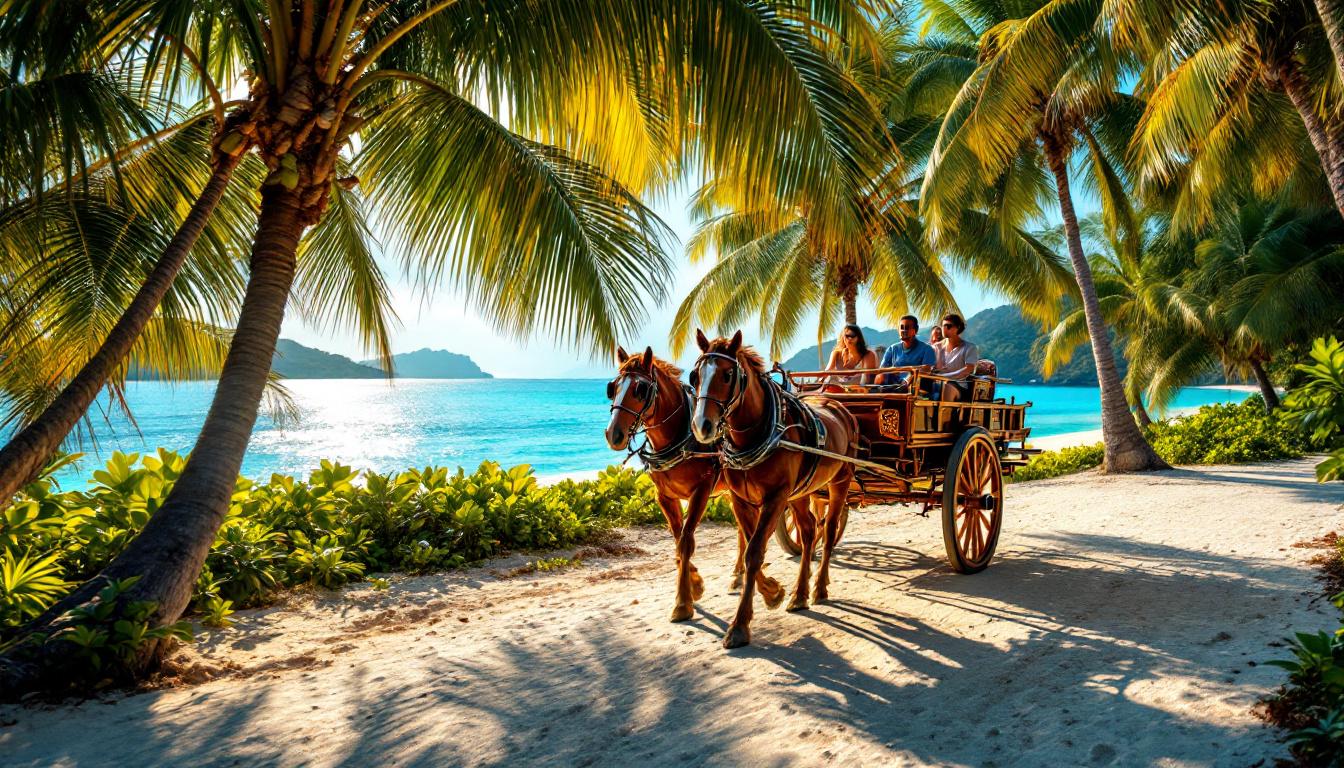Most Indonesian islands overwhelm you with motorbikes, cars, and exhaust fumes cutting through tropical paradise. But imagine stepping onto land where the loudest sound is clip-clop hooves on coral paths and gentle ocean waves lapping pristine shores.
The Gili Islands remain the only Indonesian destination where traditional horse-drawn carriages called cidomos replace every single motorized vehicle. While Bali suffocates under traffic chaos and Lombok bustles with scooter mayhem, these three tiny islands preserve an authentic transportation system that hasn’t changed for generations.
August delivers perfect 80°F weather when monsoons batter Thailand and Vietnam, making this the ideal time to discover Indonesia’s best-kept secret. The timing couldn’t be more perfect for escaping Southeast Asia’s wettest season while enjoying crystalline waters and endless sunshine.
The unique transport system that stopped time
Horse carriages that connect three pristine islands
Cidomos serve as the primary transport across Gili Trawangan, Gili Meno, and Gili Air, carrying two passengers plus luggage for around $3 per ride. These traditional horse-drawn carts navigate coral-paved paths that wind through coconut groves and fishing villages untouched by modern development. Local families have operated these carriages for generations, maintaining horses through improved welfare programs supported by international conservation groups.
The complete vehicle ban that preserves paradise
Absolutely zero motorized vehicles exist on any of the three islands, creating an atmosphere of tranquility impossible to find elsewhere in Indonesia. Walking between beaches takes just two hours around each island’s perimeter, while bicycle rentals cost only $2.70 daily. This strict environmental protection policy ensures coral reefs remain pristine and traditional island life continues undisturbed by modern transportation chaos.
Perfect weather when Southeast Asia gets soaked
August temperatures that beat regional alternatives
While Bangkok floods and Vietnamese beaches close due to torrential monsoons, the Gilis enjoy consistent 82°F highs and 77°F lows throughout August. The dry season delivers only 2 rainy days monthly with minimal precipitation, compared to Thailand’s daily downpours and Malaysia’s stormy chaos. Sea temperatures hold steady at perfect 81°F for swimming and snorkeling in calm, crystal-clear conditions.
Nine hours of daily sunshine during monsoon season
Bright sunshine fills 78% of daylight hours in August, creating ideal conditions for beach activities and coral reef exploration. UV levels reach extreme intensity between noon and 2pm, requiring proper sun protection, but gentle trade winds keep temperatures comfortable throughout the day. This weather window offers the region’s most reliable tropical paradise experience when neighboring countries battle seasonal storms.
Authentic Indonesian culture without tourist chaos
Local fishing communities that welcome respectful visitors
Traditional Indonesian fishing families maintain their ancestral lifestyle across all three islands, with morning catches bringing fresh seafood directly to local warungs and night markets. Islamic prayer calls echo peacefully across the water five times daily, creating a spiritual atmosphere that contrasts sharply with party-focused destinations like Kuta or Seminyak.
Environmental protection that locals actively defend
Community-driven conservation initiatives protect coral reefs through strict boat anchoring regulations and waste management programs that keep beaches pristine. Local authorities enforce the vehicle ban rigorously, ensuring traditional island character remains intact despite growing tourism interest. Water sanitation projects and renewable energy initiatives demonstrate authentic commitment to sustainable development.
Surprisingly accessible despite remote reputation
Multiple boat connections from major Indonesian hubs
Fast boats from Bali’s Padang Bai Harbor reach Gili Trawangan in 90 minutes for around $20 one-way, while public boats from Lombok’s Bangsal Harbor take just 30 minutes for $1.50. Speedboat services operate every 30-45 minutes between 8am and 5pm, connecting all three islands with reliable transportation that contradicts the “difficult to reach” reputation.
Inter-island hopping made simple and affordable
Public ferries connect all three Gilis twice daily at 9:30am and 4pm for $2.50 per hop, while private speedboats offer flexible scheduling for $5.50 one-way. Each island offers distinct personalities – Trawangan for sunset views, Meno for turtle sanctuaries, and Air for authentic fishing village experiences.
Frequently asked questions
How safe are the horse carriages for transportation?
Cidomos operate under improved welfare standards with regular veterinary care and proper equipment maintenance, making them safe and comfortable for tourist transportation across the islands.
Can you swim between the islands instead of taking boats?
Swimming between islands is extremely dangerous due to strong currents that have caused drowning incidents. Always use official boat services for inter-island travel safety.
What makes August the best time to visit?
August offers perfect dry season weather with minimal rain and ideal sea conditions, while regional alternatives like Thailand and Vietnam experience heavy monsoons.
The Gili Islands prove that authentic Indonesian paradise still exists without sacrificing convenience or comfort. August’s perfect weather window creates the ideal opportunity to experience this unique transportation system and pristine island environment before word spreads further.
